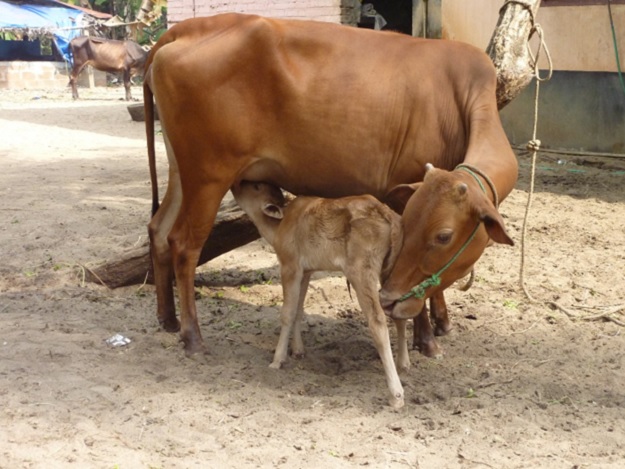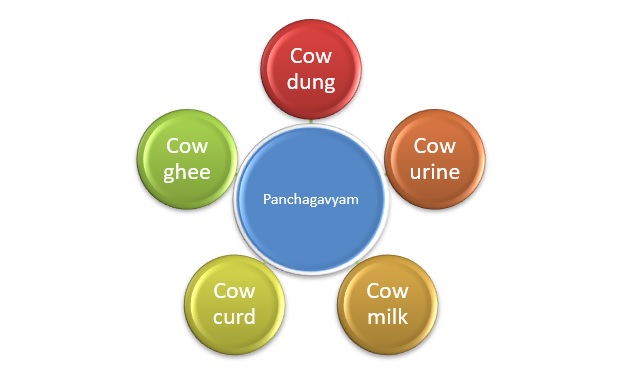Apr 30, 2025
Apr 30, 2025
by Sujata C

Image (c) Microsoft Office Stock Library
Panchagavyam is a unique cow product-based blend that is used in several Hindu rituals. There is mention of panchagavyam in Charaka Samhita and Vrkshayurveda (an ancient Indian text on plant health). Its use was standard practice in disease management in Vedic times.
Farmers in India have an option to chemical fertilizers and pesticides in Panchagavya as this ancient remedy acts as a growth stimulant and a pest inhibitor in plants, fishes, animals and humans. It has succeeded in revolutionizing the crop production and animal husbandry in many parts of the country in recent times.
The resurgence of organic farming has witnessed a revival of ancient farming practices in India that sustained the world for over 6000 years. The use of Panchagavyam is one such practice. Recognizing the value of cow products, the Council for Scientific Industrial Research (CSIR), India has obtained a US patent (No.689690 / and 6410059) in 2010, for cow urine distillate for its effectiveness as an antimicrobial, antifungal, anti-cancer agent and bio-enhancer. This has come as a huge boost to organic farmers. The revival has seen Maharashtra take a lead in promoting organic farming with traditional practices. The state government has even formulated a special policy for the sector. In Tamilnadu there is greater awareness of panchagavyam as the society is more tradition oriented.
The cow concoction is known by different names in different parts of the country as the composition varies from place to place. But the knowledge base is the same as it comes from the Vedas.
What is Panchagavyam
Panchagavyam is a combination of five products obtained from the cow including dung, urine, milk, curd and ghee or clarified butter.

How does it work: Field trials followed by soil testing done by Centre for Indian Knowledge Systems have shown that panchagavyam improves the soil pH and available nutrients for the plant. Lab studies done by Central Bio Control Laboratory, Chengalpattu, Tamilnadu, found that microorganisms present in Panchagavyam, include nitrogen fixing azospirillum, nitrogen fixing azatofactor, phosphor bacteria, pseudomonas, useful fungi and actinomycetes. Private labs in Chennai have also carried out similar studies and found that it contains all essential macro and micro nutrients required for plant health.
Measurable benefits:
Dr K Natarajan, President Rural Community Action Centre, Erode Tamilnadu is known for his bio-dynamic farming practices. He trains farmers in the making the product while pursuing his experimentation with additional ingredients. He says “Panchagavyam advances harvest by 15 days, increases the weight of the produce, enhances the shelf life of vegetables and fruits, and improves the taste, flavour and aroma. It also increases sugar content in fruits by 25%, oil content in oil seeds by 25% and gets better price for the produce.”
Through his experimentations, Dr Natarajan has been able to prolong the shelf life of panchagavyam from 45 days to 6 months.
Field Impact:
S Eswaramoorthy a jasmine farmer in Karuttopalayam, Tamilnadu says, “I have used panchgavyam in jasmine fields. It improves the fragrance of the flowers exceptionally and the flowers fetch better price in the market nearly 30% more than the rate of the day. What is unique is that the plants flowers even during winter, a non-season for jasmine with panchagvyam.”
K Ramasamy from Arikkarankattur in Tamilnadu, a horticulturist noticed significant difference in his drumstick field. “The flowering of the tree continued well beyond five months, normally it stops within four months. The chemical pesticide could never control the fruit fly and leaf webber pests, but panchagvyam was able to effectively control the pests as well as increase yield,” he says.
Dr G V Ramanjaneyulu, Executive Director of Centre for Sustainable Agriculture, an NGO based in Hyderabad has been advocating the use of traditional farm practices among farmers of Andhra Pradesh. He says, “Farmers response to panchagavyam in ten years has been very good and there has been almost 50% reduction in the use of chemical fertilizers. But the cow has to be a local breed and fed on fodder alone to get the optimum microbial content in the final product.” Panchagavyam is also used for seed and seedling treatment before planting and to reduce pest infestation during storage, he says.
The rise of the superbugs:
The rise of superbugs is a dangerous reality still waiting to be acknowledged. Anti-biotic resistance is one of the biggest hazards to global health and diseases outpace antibiotics faster than we can cure them according to a WHO report. At this juncture alternate medicines need to be seriously explored to achieve sustainable development goals. Panchagavya is known to restrict cancerous growth.
A panacea for all ills
Panchagavyam is known to have curative properties for a range of complex diseases in humans, including psoriasis, Alzheimer, diabetes and cancer. Go Vigyan Anusandhan Kendra in village Deolapar, Nagpur promotes panchagavya for its medicinal properties human ailments. Research published in Asian Journal for Pharmaceutical and Clinical Research says that panchagavyam possesses anticonvulsant properties. “Panchagavya is capable of multipronged attack on infection caused due to tridoshas or imbalance in the vata, pitta and kapha. It detoxifies the body” says Vaidya Ganga Satyam, an ayurvedic doctor in Hyderabad who regularly prescribes panchagavya for a range of illnesses from diabetes to cancer.
However, panchgavya has to be prepared with special care with due precautions for optimum results due to the bio dynamic nature of the product. Dr A V Balasubramanium of Centre for Indian Knowledge Systems says, “The field results cannot be replicated as the ingredients are natural (the five cow products ) and their composition varies with diet, seasons and health of the cow.”
Given the numerous benefits, why don’t cow shelters which abound in India make commercial capital out of this product? Ashok Kumar Agarwal of Agrasena Maharaj Goshala Hyderabad says, “We face a labour problem. Nobody comes forward to do this work as the cow dung and urine has to be collected fresh. The resource input is higher than the returns we may get. Besides, most cow shelters are not commercial centers and we even donate the milk given by the cows.” Preparation of panchagavyam requires training and manpower so not many have come forward to take it up AP. “In Maharashtra they get better returns as one truck load of cow dung goes for Rs 4000/-, but in AP you are lucky if you get Rs 500/-,” he rues.
Panchagavyam is not readily available off the shelf as it custom made to suit the requirements of farmers or patients as the case maybe. The recipe may also vary for crop to crop with necessary herbs being added for certain crops as the case maybe. Most Ayurvedic doctors obtain their medicinal form of panchagavyam from Nagpur. The standard practice is to train the farmers or doctors to make the potion by themselves. The making of panchagavyam is an ancient community knowledge and what we are witnessing is a revival of this lost knowledge at the grassroot level. Some private manufacturers are leveraging the back to nature trend with panchagavyam products like soap, shampoo and hair oils and making profits from this magic potion. But there still a long way to go for something like a market to develop for panchagavyam, though that would be a dream come true for all those associated with it.
Points to Ponder:
Ancient wisdom of India always blended social rituals with scientific reasons. By preserving the traditional knowledge of India, we preserve our cultural heritage and that is important as it is part of our identity.
Images provided by the author
21-May-2022
More by : Sujata C